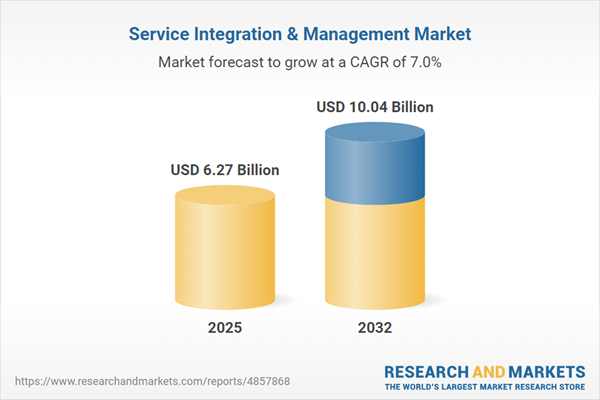Speak directly to the analyst to clarify any post sales queries you may have.
Service Integration and Management (SIAM) plays a pivotal role in guiding enterprises through today’s digital complexities, enabling organizations to harmonize multivendor service delivery, streamline governance, and reduce integration risk as digital transformation initiatives accelerate across global business landscapes.
Market Snapshot: Growth Trajectory in the Service Integration & Management Market
The Service Integration & Management Market grew from USD 5.86 billion in 2024 to USD 6.27 billion in 2025. With a projected CAGR of 6.95%, the market is expected to achieve USD 10.04 billion by 2032. This stable expansion reflects the rising demand for structured integration frameworks, advanced automation, and outcome-based contracting in a rapidly evolving digital ecosystem.
Scope & Segmentation
This report provides a comprehensive analysis across multiple service categories and regions. The segmentation addresses the key elements influencing market dynamics and client priorities:
- Service Type: Managed Services, Professional Services (Consulting, Implementation, Integration), Support Services, Training Services
- Deployment Mode: On Cloud, On-Premises
- Enterprise Size: Large Enterprises, Small and Medium Enterprises
- Industry Vertical: Government & Defense, Healthcare, IT & Telecommunication, Retail & E-Commerce
- Region: Americas (United States, Canada, Mexico, Brazil, Argentina, Chile, Colombia, Peru), Europe, Middle East & Africa (United Kingdom, Germany, France, Russia, Italy, Spain, Netherlands, Sweden, Poland, Switzerland, United Arab Emirates, Saudi Arabia, Qatar, Turkey, Israel, South Africa, Nigeria, Egypt, Kenya), Asia-Pacific (China, India, Japan, Australia, South Korea, Indonesia, Thailand, Malaysia, Singapore, Taiwan)
- Key Companies: Accenture plc, International Business Machines Corporation, Tata Consultancy Services Limited, Capgemini SE, Cognizant Technology Solutions Corporation, DXC Technology Company, Infosys Limited, Wipro Limited, HCL Technologies Limited, Atos SE
Primary Keyword: Service Integration and Management
Key Takeaways for Senior Decision-Makers
- Successful integration depends on the ability to orchestrate diverse providers through centralized governance and robust performance monitoring.
- Cloud-native and microservices architectures are enabling flexible, modular approaches that support faster deployment cycles and agility.
- Rising regulatory demands, especially in Europe and sectors like government and healthcare, require organizations to embed compliance into integration pipelines.
- Strategic vendor collaboration, targeted acquisitions, and innovation partnerships are defining the competitive landscape among leading solution providers.
- Cross-functional talent development and ecosystem alliances help organizations maintain alignment with evolving business objectives and accelerate digital initiatives.
Tariff Impact on Service Integration Costs and Sourcing
Changing United States tariff policies are significantly affecting integration budgets. Duties imposed on essential hardware and technology components drive organizations to reevaluate total cost of ownership and diversify their sourcing strategies. Flexible contracting and localized partnerships are now central to reducing cost volatility and insulating supply chains from geopolitical risk.
Methodology & Data Sources
This report adopts a rigorous research approach, combining in-depth interviews with senior stakeholders and comprehensive analysis of industry reports. Data triangulation ensures findings are validated across primary and secondary sources. Iterative expert reviews provide additional context and increase reliability throughout the research process.
Why This Report Matters
- Delivers incisive insights into the Service Integration and Management market, supporting strategic planning for digital transformation initiatives.
- Offers practical, actionable recommendations to optimize integration processes, from governance office creation to automation and cross-enterprise coordination.
- Clarifies how evolving regulatory, technological, and geopolitical factors affect sourcing, vendor management, and cost-control strategies.
Conclusion
This report equips senior leaders with a clear roadmap for navigating service integration complexities, highlighting strategies that foster resiliency, cost optimization, and operational excellence. Informed by robust research, it unlocks direction for competitive differentiation and sustainable enterprise growth.
Additional Product Information:
- Purchase of this report includes 1 year online access with quarterly updates.
- This report can be updated on request. Please contact our Customer Experience team using the Ask a Question widget on our website.
Table of Contents
3. Executive Summary
4. Market Overview
7. Cumulative Impact of Artificial Intelligence 2025
Companies Mentioned
The companies profiled in this Service Integration & Management market report include:- Accenture plc
- International Business Machines Corporation
- Tata Consultancy Services Limited
- Capgemini SE
- Cognizant Technology Solutions Corporation
- DXC Technology Company
- Infosys Limited
- Wipro Limited
- HCL Technologies Limited
- Atos SE
Table Information
| Report Attribute | Details |
|---|---|
| No. of Pages | 197 |
| Published | November 2025 |
| Forecast Period | 2025 - 2032 |
| Estimated Market Value ( USD | $ 6.27 Billion |
| Forecasted Market Value ( USD | $ 10.04 Billion |
| Compound Annual Growth Rate | 6.9% |
| Regions Covered | Global |
| No. of Companies Mentioned | 11 |









